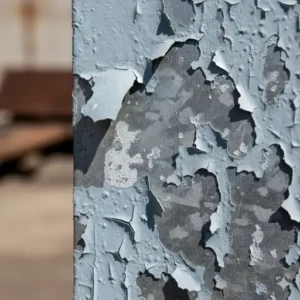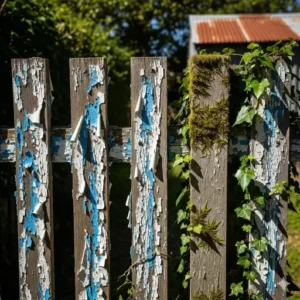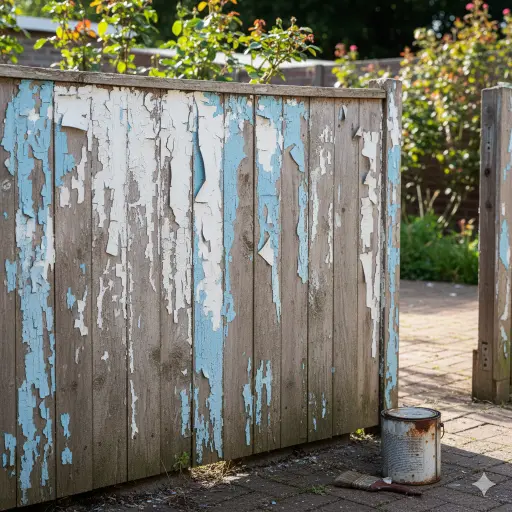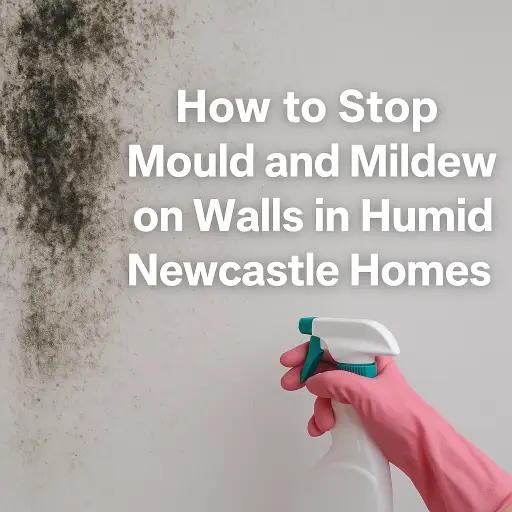Why Your Fence Paint Peels and How to Stop It
Is there anything more frustrating than spending a weekend painting your fence, only to see it bubbling and peeling a year later? Here in Newcastle, our combination of sun, humidity, and salty air can be brutal on painted surfaces.
You’re not alone in this battle. Most paint failures aren’t due to bad paint, but to a few hidden culprits that are easy to miss.
As professional fence painters in Newcastle, we see this all the time. The good news is that with the right preparation and knowledge, you can get a beautiful, long-lasting finish. This guide will walk you through why your fence paint is failing and exactly how to fix it for good.
Why Your Fence Paint Is Failing
Before we grab a brush, let’s look at the three main culprits that ruin a paint job.
1. Water (Moisture) Water is paint’s number one enemy. It gets trapped in timber, making it swell and pushing the paint off from behind in blisters. It also helps mould and mildew grow.
- The Fix: Before painting timber, its moisture level should be below 15%. A professional painter will use a moisture meter to check this.
2. Sun (UV Rays) Our strong Aussie sun is like an oven. It bakes the paint, breaking down its protective binders. This leaves a chalky powder on the surface and weakens the paint’s grip.
- The Fix: Lighter colours reflect more sun, but proper prep work is far more important for long-term protection.
3. Salt and Chemicals: If you live near the coast or have a pool, salt is a major issue. Salt crystals get under the paint, attract moisture, and rapidly speed up rust on metal fences. This rust lifts the paint from underneath.
- The Fix: The fence needs a thorough rinse to remove salt before any other prep work begins. You also need to use special rust-fighting primers.
10 Common Painting Mistakes We See in Newcastle
Beyond the big three, here are some common shortcuts that lead to a peeling fence:
- Painting in the Wrong Weather: Paint needs the right conditions to dry properly. Don’t paint when it’s below 10°C or if the air is too humid.
- Skipping the Clean: You can’t paint over dirt, grease, or old, chalky paint. The new coat will stick to the grime, not the fence, and will quickly peel away.
- Using the Wrong Primer on Metal: New shiny galvanised steel needs a special “etch primer” to grip onto. Using a standard primer is like trying to stick Teflon to Teflon—it just won’t work.
- Painting COLORBOND® incorrectly: You can refresh your COLORBOND® fence, but you must follow the official guide from BlueScope. This involves cleaning, a light sanding, and using the right products.
- Painting Over Rust: Covering rust with paint is like putting a Band-Aid on a broken arm. The rust will continue to creep underneath, lifting your new paint job with it.
- Painting Damp Timber: As we mentioned, timber full of moisture will push paint off in bubbles and blisters.
- Ignoring “Unwashed Zones”: Areas under fence capping or behind posts don’t get rinsed by rain. Salt and dirt build up here, causing rust to start.
- Rushing Between Coats: Every paint has a specific drying time. If you apply the next coat too soon, you trap moisture or solvents, leading to a soft, weak finish.
- Applying Paint Too Thin or Too Thick: The paint can’s instructions will tell you the ideal thickness. Too thin, and it won’t protect against the sun. Too thick, and it can crack and peel.
- Forgetting Pool Chemicals: The chlorine and salt vapour around a swimming pool create a very corrosive environment. Your fence needs a high-performance paint system designed for these tough conditions.
How to Repaint a Metal Fence (Like COLORBOND®) the Right Way
Getting a professional finish on a metal fence means doing the prep work properly. The goal is to remove all rust and create a clean, solid base for the new paint to stick to.
- Step 1: Inspect: Look closely for any rust spots, chalky paint, or peeling areas. Check if different types of metals are touching each other (like copper pipes against a steel post), as this can cause rust.
- Step 2: Deep Clean: Hose the fence down to get rid of loose dirt. Then, wash it with a product like Sugar Soap and rinse it completely. If you’re near the coast, this rinse is crucial to remove hidden salt.
- Step 3: Sand and Scuff: The goal here isn’t to remove all the old paint, but to take the shine off it. A light scuff with sandpaper gives the new primer something to grip.
- Step 4: Treat the Rust: For any rusty spots, you need to grind the rust back to bare, shiny metal.
- Step 5: Prime the Right Way: This is the most important step.
- On bare steel or repaired rust spots, use a zinc-rich or anti-corrosive primer. We recommend products from the Dulux Metalshield range.
- On bare galvanised steel, use a specialised etch primer.
- Step 6: Paint in Good Weather: Wait for a dry day that’s not too hot or too cold (ideally between 10°C and 30°C).
- Step 7: Apply Two Top Coats: Use a quality exterior paint like Dulux Weathershield. Applying two coats gives you the best colour and protection against the sun. Make sure you let the first coat dry properly before starting the second.
- Step 8: Check Your Screws: If the screws are rusty, replace them. This stops the rust from spreading to the fence panels.

How to Repaint a Peeling Timber Fence
Timber fences have different needs, mainly related to moisture and mould.
- Step 1: Check for Moisture: Press a moisture meter into the timber. If the reading is over 15%, you need to wait for the fence to dry out more before you can paint.
- Step 2: Clean and Kill Mould: If you see any green or black spots, treat them with a mould killer like 30 Seconds Outdoor Cleaner. Then, give the fence a good wash and let it dry completely.
- Step 3: Sand and Fill: Sand any peeling edges to make them smooth. Fill any cracks or holes with a quality exterior wood filler.
- Step 4: Prime Bare Spots: Apply a good quality exterior timber primer, like Wattyl Aqua Prep Primer Sealer, to any bare timber or filled areas. This seals the timber and stops stains from bleeding through.
- Step 5: Apply Two Top Coats: Finish with two coats of a premium exterior acrylic paint. This gives the timber the flexibility it needs to handle Newcastle’s changing temperatures and humidity.

| If your fence surface is… | The main challenge is… | Your primer solution is… | Products |
|---|---|---|---|
| New, shiny galvanised steel | Too slick for paint to grip. | Etch primer to bite into the metal. | Killrust Etch Primer. (wattyl.com.au) |
| Bare steel or rusty patches | Rust returns fast if you just paint over it. | Zinc-rich / anti-corrosive primer after prep. | Killrust Cold Galvit (zinc-rich) or Killrust Heavy Duty Primer. (wattyl.com.au) |
| Bare spots on COLORBOND® | Need adhesion to factory finish and protection on exposed edges. | Super Etch primer that keys to COLORBOND®/ZINCALUME®. | Super Etch Primer. (info.wattyl.com.au) |
| Bare or weathered timber | Timber is thirsty and goes patchy. | Acrylic timber primer to seal and level. | Aqua Prep Acrylic Timber Primer. (Wattyl Australia) |
| Timber with dark stains/tannins | Brown stains bleeding through new paint. | Oil-based stain-blocking timber primer. | Zinsser Cover-Stain Primer-Sealer |
Maintenance Schedule
| Fence Type | Quick Check Every | Full Recoat Every | Tip |
|---|---|---|---|
| COLORBOND® | 12 months | 10–15 years | Wash down with hose twice a year |
| Timber | 6 months | 5–7 years | Reapply sealer or repaint before cracking |
| Steel | 12 months | 7–10 years | Touch up chips quickly to stop rust |
Why Proper Prep Matters for Fence Painters in Newcastle
Newcastle’s climate is a real test for any paint job. The morning humidity, salty air from our beautiful coastline, and strong summer sun all work together to make paint fail. Rushing the preparation is a recipe for peeling and rust.
By following the right steps and using the right products, you ensure your hard work pays off with a fence that looks fantastic for years, not just months.
Tired of dealing with a peeling fence? Let the experts handle it.
Procover Painting are the fence painters Newcastle residents trust for a finish that lasts. We understand our local climate and use the correct preparation techniques and products to guarantee a flawless result.
We are fully insured, offer a 5-year workmanship warranty, and service all of Newcastle, Lake Macquarie, Maitland, and Port Stephens.
Call us today on 0430 823 631 or visit procoverpainting.com.au for a free, no-obligation quote.





